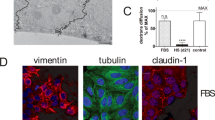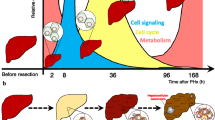Summary
In order to understand how cancer cells accumulate, rat hepatoma ARL-6 cells were cultured for 8 d to identify factors involved in spontaneous cell proliferation and apoptosis. With increasing time in culture, the proportion of cells in the proliferative phases of the cell cycle and the rate of deoxyribonucleic acid (DNA) synthesis decreased. The waning of proliferation was associated with a gradual reduction of cell viability, and this was temporally related to the appearance of typical apoptotic morphology and DNA laddering. Medium replacement or supplementation with fetal calf serum (FCS) suppressed apoptosis, while medium change, but not fetal calf serum alone, enhanced cell proliferation. Apoptosis was also suppressed by dimethyl sulfoxide (DMSO), but supplementary glutathione was without effect. Expression of poly(adenosine diphosphate[ADP]-ribose)polymerase peaked on days 3–4 of culture, and was followed by a progressive decrease thereafter, consistent with proteolytic cleavage. This decrease was prevented to varying extents by complete medium replacement, FCS and DMSO, indicating a close temporal relationship between poly(ADP-ribose)polymerase activation and apoptosis. Expression of Fas and Bcl-2 did not change appreciably over the 8-d culture, but there was a gradual increase in Bax expression; medium change, FCS and DMSO all partly inhibited Bax expression. These data indicate that spontaneous apoptosis in cultured ARL-6 cells is inversely related to cell proliferation, and that nutrient supply, and to a lesser extent, serum-derived factors and oxidative stress modulate apoptosis in this system. Proteolytic cleavage of poly(ADP-ribose)polymerase and expression of Bax are likely to be mechanistically involved with the control of spontaneous apoptosis in ARL-6 cells, whereas changes in the levels of Fas and Bcl-2 do not play a role.
Similar content being viewed by others
References
Aragane, Y.; Kulms, D.; Metze, D.; Wilkes, G.; Pöppelmann, B.; Luger, T. A.; Schwarz, T. Ultraviolet light induces apoptosis via direct activation of CD 95 (Fas/APO-1) independently of its ligand CD 95L. J. Cell Biol. 140:171–182; 1998.
Arends, M. J.; McGregor, A. H.; Wyllie, A. H. Apoptosis is inversely related to necrosis and determines net growth in tumors bearing constitutively expressed myc, ras, and HPV oncogenes. Am. J. Pathol. 144:1045–1057; 1994.
Barrett, J. C.; Preston, G. Apoptosis and cellular senescence: forms of irreversible growth arrest. In: Tomei, L. D.; Cope, F. O., ed. Apoptosis II: the molecular basis of apoptosis disease. New York: Cold Spring Harbor Laboratory Press; 1994:253–281.
Bursch, W.; Oberhammer, F.; Schulte-Hermann, R. Cell death by apoptosis and its protective role against disease. Trends Pharmacol. Sci. 13:245–251; 1992.
Celli, A.; Que, F. G.; Gores, G. J.; LaRusso, N. F. Glutathione depletion is associated with decreased Bcl-2 expression and increased apoptosis in cholangiocytes. Am. J. Physiol. 275:G749-G757; 1998.
Chateau, M. T.; Ginestier-Verne, C.; Chiesa, J.; Caravano, R.; Bureau, J. P. Dimethyl sulfoxide-induced apoptosis in human leukemic U937 cells. Anal. Cell Pathol. 10:75–84; 1996.
Collins, M. K.; Perkins, G. R.; Rodriguez-Tarduchy, G.; Nieto, M. A.; Lopez-Rivas, A. Growth factors as survival factors: regulation of apoptosis. Bioessays 16:133–138; 1994.
Ellis, R. E.; Juan, J.; Horvitz, H. R. Mechanisms and functions of cell death. Annu. Rev. Cell Biol. 7:663–698; 1991.
Estoppey, S.; Rodriguez, I.; Sadoul, R.; Martinou, J. C. Bcl-2 prevents activation of CPP32 cysteine protease and cleavage of poly(ADP-ribose) polymerase and UI-70 kD proteins in staurosporine-mediated apoptosis. Cell Death Differ. 4:34–38; 1997.
Evan, G. I.; Wyllie, A. H.; Gilbert, C. S., et al. Induction of apoptosis in fibroblasts by c-myc protein. Cell 69:119–128; 1992.
Fau, D.; Lekehal, M.; Farrell, G.; Moreau, A.; Moulis, C.; Feldmann, G.; Haouzi, D.; Pessayre, D. Diterpenoids from germander, an herbal medicine, induce apoptosis in isolated rat hepatocytes. Gastroenterology 113:1334–1346; 1997.
Forrest, V. J.; Kang, Y. H.; McClain, D. E.; Robinson, D. H.; Ramakrishnan, N. Oxidative stress-induced apoptosis prevented by Trolox. Free Radic. Biol. Med. 16:675–684; 1994.
Galle, P. R.; Hofmann, W. J.; Walczak, H.; Schaller, H.; Otto, G.; Stremmel, W.; Krammer, P. H.; Runkel, L. Involvement of the CD 95 (APO-1/Fas) receptor and ligand in liver damage. J. Exp. Med. 182:1223–1230; 1995.
Gerschenson, L. E.; Rotello, R. J. Apoptosis and cell proliferation are terms of the growth equation. In: Tomei, L. D.; Cope, F. O., ed. Apoptosis I: the molecular basis of cell death. New York: Cold Spring Harbor Laboratory Press; 1991:175–192.
Grassilli, E.; Carcereri de Prati, A.; Monti, D.; Troiano, L.; Menegazzi, M.; Barbieri, D.; Franceschi, C.; Suzuki, H. Studies of the relationship between cell proliferation and cell death. II. Early gene expression during concanavalin A-induced proliferation or dexamethasone-induced apoptosis of rat thymocytes. Biochem. Biophys. Res. Commun. 188:1261–1266; 1992.
Green, D. R.; Martin, S. J. The killer and the executioner: how apoptosis controls malignancy. Curr. Opin. Immunol. 7:694–703; 1995.
Hug, H. Fas-mediated apoptosis in tumor formation and defense. Biol. Chem. 378:1405–1412; 1997.
Isacson, C.; Kessis, T. D.; Hedrick, L.; Cho, K. R. Both cell proliferation and apoptosis increase with lesion grade in cervical neoplasia but do not correlate with human papillomavirus type. Cancer Res. 56:669–674; 1996.
Kaufmann, S. H.; Desnoyers, S.; Ottaviano, Y.; Davidson, N. E.; Poirier, G. G. Specific proteolytic cleavage of poly(ADP-ribose) polymerase: an early marker of chemotherapy-induced apoptosis. Cancer Res. 53:3976–3985; 1993.
Kerr, J. F.; Winterford, C. M.; Harmon, B. V. Apoptosis. Its significance in cancer and cancer therapy. Cancer 73:2013–2026; 1994.
Kerr, J. F.; Wyllie, A. H.; Currie, A. R. Apoptosis: a basic biological phenomenon with wide-ranging implications in tissue kinetics. Br. J. Cancer 26:239–257; 1972.
Korsmeyer, S. J. Regulators of cell death. Trends Genetics 11:101–105; 1995.
Kroemer, G.; Petit, P.; Zamzami, N.; Vayssiere, J. L.; Mignotte, B. The biochemistry of programmed cell death. FASEB J. 9:1277–1287; 1995.
Lazebnik, Y. A.; Kaufmann, S. H.; Desnoyers, S.; Poirier, G. G.; Earnshaw, W. C. Cleavage of poly(ADP-ribose) polymerase by a proteinase with properties like ICE. Nature 371:346–347; 1994.
Leverkus, M.; Yaar, M.; Gilchrest, B. A.: Fas/Fas ligand interaction contributes to UV-induced apoptosis in human keratinocytes. Exp. Cell Res. 232:255–262; 1997.
Marvel, J.; Perkins, G. R.; Lopez, R. A.; Collins, M. K. Growth factor starvation of Bel-2 overexpressing murine bone marrow cells induced refractoriness to IL-3 stimulation of proliferation. Oncogene 9:1117–1122; 1994.
McClain, D. E.; Kalinich, J. F.; Ramakrishnan, N. Trolox inhibits apoptosis in irradiated MOLT-4 lymphocytes. FASEB J. 9:1345–1354; 1995.
Mignotte, B.; Vayssiere, J. L. Mitochondria and apoptosis. Eur. J. Biochem. 252:1–15; 1998.
Mochizuki, K.; Hayashi, N.; Hiramatsu, N.; Ktayama, K.; Kawanishi, Y.; Kasahara, A.; Fusamoto, H.; Kamada, T. Fas antigen expression in liver tissues of patients with chronic hepatitis B., J. Hepatol. 24:1–7; 1996.
Nagata, S. Fas-mediated apoptosis. Adv. Exp. Med. Biol. 406:119–124; 1996.
Negri, C.; Bernardi, R.; Donzelli, M.; Prosperi, E.; Scovassi, A. I. Sequence of events leading to apoptosis in long term cultured HeLa cells. Cell Death Differ. 3:425–430; 1996.
Nicoletti, I.; Migliorati, G.; Pagliacci, M. C.; Grignani, F.; Riccardi, C. A rapid and simple method for measuring thymocyte apoptosis by propidium iodide staining and flow cytometry. J. Immunol. Methods 139:271–279; 1991.
Oberhammer, F.; Wilson, J. W.; Dive, C.; Morris, I. D.; Hickman, J. A.; Wakeling, A. E.; Walker, P. R.; Sikorska, M. Apoptotic death in epithelial cells: cleavage of DNA to 300 and/or 50 kb fragments prior to or in the absence of internucleosomal fragmentation. EMBO J. 12:3679–3684; 1993.
Patel, T.; Gores, G. J. Inhibition of bile-salt-induced hepatocyte apoptosis by the antioxidant lazaroid U83836E. Toxicol. Appl. Pharmacol. 142:116–122; 1997.
Peitsch, M. C.; Mannherz, H. G.; Tschopp, J. The apoptosis endonucleases: cleaning up after cell death?. Trends Cell Biol. 4:37–41; 1994.
Perry, D. K.; Smyth, M. J.; Wang, H. G.; Reed, J. C.; Duriez, P.; Poirier, G. G.; Obeid, L. M.; Hannun, Y. A. Bcl-2 acts upstream of the PARP protease and prevents its action. Cell Death Differ. 4:29–33; 1997.
Qiao, L.; Farrell, G. C. The effects of cell density, attachment substratum and dexamethasone on spontaneous apoptosis of rat hepatocytes in primary, culture. In Vitro Cell. Dev. Biol. 35:417–424; 1999.
Reed, J. C. Bcl-2 and the regulation of programmed cell death. J. Cell Biol. 124:1–6; 1994.
Shaposhnikov, Y.; Maheshwari, Y.; Sykes, D. E.; Weiser, M. M. Intestinal cell apoptosis and bcl-2 expression. Cell Death Differ. 3:125–130; 1996.
Sherwood, S. W.; Schimke, R. T. Cell cycle analysis of apoptosis using flow cytometry. Methods Cell Biol. 46:77–97; 1995.
Terada, T.; Nakanuma, Y. Expression of apoptosis, proliferating cell nuclear antigen, and apoptosis-related antigens (bcl-2, c-myc, Fas, Lewisy and p53) in human cholagiocarcinoma and hepatocellular carcinomas. Pathol. Int. 46:764–770; 1996.
Teramoto, S.; Tomita, T.; Matsui, H.; Ohga, E.; Matsuse, T.; Ouchi, Y. Hydrogen peroxide-induced apoptosis and necrosis in human lung fibroblasts: protective roles of glutathione. Jpn. J. Pharmacol. 79:33–40; 1999.
Vlachaki, M. T.; Meyn, R. E. ASTRO research fellowship: the role of BCL-2 and glutathione in an antioxidant pathway to prevent radiation-induced apoptosis. Int. J. Radiat. Oncol. Biol. Phys. 42:185–190; 1998.
Wyllie, A. H. Cell death in tissue regulation. J. Pathol. 153:313–316; 1987.
Author information
Authors and Affiliations
Corresponding author
Rights and permissions
About this article
Cite this article
Qiao, L., Farrell, G.C. Reciprocal control of apoptosis and proliferation in cultured rat hepatoma arl-6 cells: Roles of nutrient supply, serum, and oxidative stress. In Vitro Cell.Dev.Biol.-Animal 36, 465–475 (2000). https://doi.org/10.1290/1071-2690(2000)036<0465:RCOAAP>2.0.CO;2
Received:
Accepted:
Issue Date:
DOI: https://doi.org/10.1290/1071-2690(2000)036<0465:RCOAAP>2.0.CO;2




